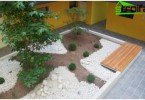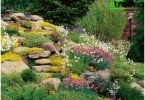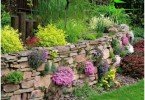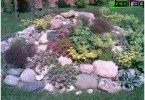Blooming flowerbeds are the pride of the gardener, his visiting card, emphasizing that the garden is not only a means of providing the table with food, but also a hobby, a piece of the soul. Especially pleasing to the eye are the plants of spring flower beds, a riot of colors confirming that spring has finally come.
Content
- Preliminary preparation of flower beds for spring flowers
- Perennial early flowering garden plants
- Biennial early flowers
- Annual plants in a spring flower garden
- Organization of flower beds in the spring garden
Preliminary preparation of flower beds for spring flowers
To proudly show guests a flowering flowerbed in spring, it is necessary to smash it the previous fall, and it is not only about planting perennial plants. You need to start by choosing a place under the flower bed, which is especially important for primroses. This should be a well-lit area on a hill, where the earth warms up in the first place, and excess moisture will not accumulate. A slight shadow cast by fruit trees or shrubs will not interfere. The shape of the future flowerbed depends on the choice of place, and, accordingly, the principle of selecting spring flowers for it. If the shape of the flowerbed is selected round with access from all sides, then the design should be viewed from any angle. If a piece of land reserved for spring flowers adjoins close to a wall or fence, then the location of specific flowers should outperform this space.
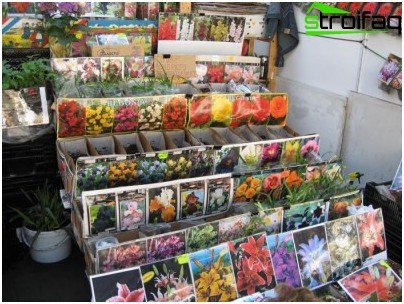
The choice of specific flower species should be based on the particular location of the flower bed and the amount of time that the gardener is willing to devote to them
Perennial early flowering garden plants
The second question that the gardener has to solve is the choice of specific species. Spring flower beds may contain perennials, biennials, and annuals. Each of these types requires attention in its own way. Perennial plants must be carefully prepared for wintering, taking care of shelter and top dressing since autumn. Annuals wait for the host in early spring, requiring soil preparation, seedling care and weather forecast control. Spring flower bed can combine these types of plants..
In the early spring, perennial periwinkles and forget-me-nots, Adonis Amursky, large dentifolia, Veronica, walnut, hellebore and astilbe are ready to please the eye. A little later, lilies of the valley, purslane, magnificent dicenter and marin root bloom. They are joined by primrose and anemones. Daisies and periwinkles are also interesting for their ability to bloom twice a season..
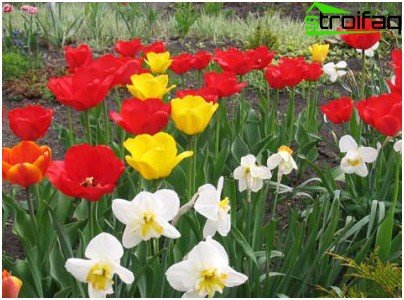
Bulb plants – the earliest and brightest perennials
Special attention is required to bulb flowers. They belong to many years, but in fact most of them are not able to survive the winter in the open ground. Bulbs are most often required to be removed from the ground, dried and planted again only in the spring. This can be done immediately after the period of their flowering, since a flower bed with such voids looks unsightly. But they are the first to please with abundant flowering. The bulb retains a sufficient supply of nutrients for quick sunrise, which means that only a little heat and sunlight are needed for flowering. You can replace dug bulbs with existing late flowering samples, again returning the flower garden to a luxurious look.
Biennial early flowers
Spring biennials can and should be changed, throwing out a plant that has outlived its life after flowering the second year. But there is an opportunity to radically change the appearance and color of the flowerbed every two years, picking up a new interesting variety. Their breeding also has subtleties: it will be necessary to select the species, color and variety in advance, for a year, since they will please bloom only after the winter season. Experienced gardeners plant a small number of biennials every year, updating the flower garden in autumn.
But biennials are unpretentious plants. They land at the end of summer and for the remainder of the season acquire roots and foliage. If the place of their planting was initially chosen successfully, then for a quick shoot they need only spring loosening of the soil, and in summer periodic watering and regular weeding. Of the easiest two-year-olds to care for, a beginner gardener can recommend mallow, viola, evening primrose and dried flowering lunaria. They are not only unpretentious to soils, but also easily tolerate autumn transplantation.
These plants are average in height and can serve as a good decoration of the space between fruit trees. Large biennials will be an excellent emphasis on any flowerbed, if you choose a decent environment from medium and short species. High biennials: digitalis, mallow, medium bell, stockroza and Turkish clove.
Annual plants in a spring flower garden
Spring annuals begin their life in the form of seedlings, in another case, they simply do not have time to reach the deadline. Especially in regions with late spring and winter, repeatedly trying to return in the form of frosts. Seedlings rise on the windowsill or in the greenhouse until the dense formation of warm days and only after that is transferred to the open ground. In case of frost, it is better to have a piece of film on hand, with which you can cover the spring flower garden if necessary. But annuals in the first year will appear in all their glory. Look good on a spring flowerbed of petunia and salvia, hibiscus, eustoma, nemophiles, marigolds and lavatera.
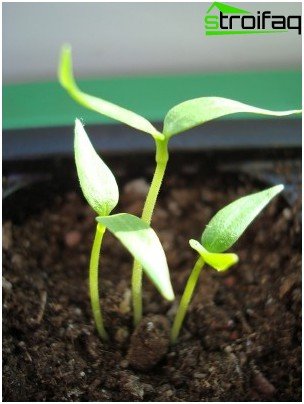
In order to plant plants in the ground in May, seedlings should be considered in early April
Annual plants in the garden are indispensable as masking perennial carpets. While the bush planted in the form of a cut is growing, it can be covered with flowering, left-handed or poppy seeds blooming in the same year.
Organization of flower beds in the spring garden
The location of spring flower gardens in the territory depends on their type, size and color. In this case, it is necessary to take into account not only the type of flowering plant, but also its condition after. Bright crocuses, causing a storm of enthusiasm when appearing through the last snow deposits, without neighbors do not look the best way, since they do not yet have foliage during flowering. Their fate is a bright spot against the background of perennials. The same situation is with daffodils, which also can not boast of their own foliage. But the bright flower will perfectly fulfill the function of a living border, delimiting the sector lines in the garden with clear lines. It is necessary to take into account the peculiarity of the flower itself, located on a rather fragile and long stem. Bushes or fences can protect it from gusts of wind if prudently planted daffodils and tulips in their immediate vicinity.
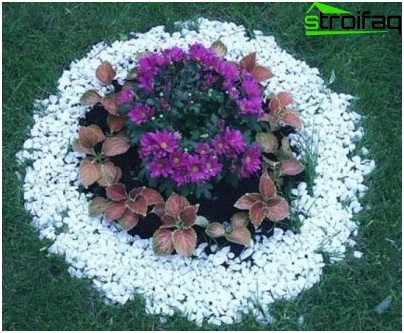
High colors require framing from medium or undersized species
If the organization of the garden implies clear lines, then plants for them should be selected bright and annual, because only they will give a clear contour of planting.
Popular types of spring flower beds, in addition to traditional round and rectangular, are:
- a mixborder consisting of plants located by a short flight of stairs from undersized in the foreground to tall along the wall;
- a discount – a wide flowerbed, emphasizing the main paths of the garden and its main areas, such as a pond or a gazebo;
- Border – a narrow row of annuals, bordering the garden sectors, including flower beds with perennials.
Caring for flower beds is a troublesome business, but the pleasure of admiring the fruits, or rather flowers, of one’s work is priceless.


